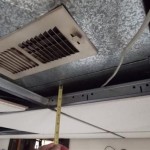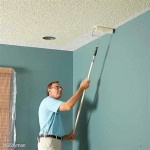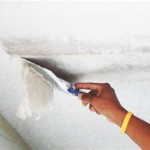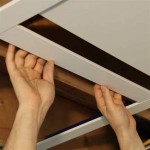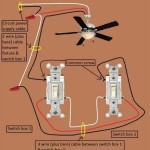How To Clean Water Stains Off Ceiling Tiles
Water stains on ceiling tiles are a common problem, often resulting from leaks in the roof or plumbing. These stains not only detract from the overall aesthetic of a room but can also indicate underlying issues that require attention. Fortunately, in many cases, these unsightly marks can be removed with readily available cleaning solutions and tools.
Before attempting any cleaning method, the source of the water leak must be identified and repaired. Cleaning the stain without addressing the root cause will only lead to recurrence and potentially more severe damage. Once the leak is fixed and the affected area is thoroughly dry, cleaning can begin.
Determining the type of ceiling tile is crucial for selecting the appropriate cleaning method. Common types include mineral fiber, acoustical, and drop-ceiling tiles. Mineral fiber tiles are porous and absorbent, making them susceptible to staining. Acoustical tiles often have a textured surface that can trap dirt and grime. Drop-ceiling tiles are typically smooth and less porous, making them easier to clean. Checking the manufacturer's guidelines or consulting a professional is recommended if there is uncertainty about the tile material.
For light water stains on non-porous tiles, a dry cleaning method is often sufficient. A soft-bristled brush, a dry microfiber cloth, or a vacuum cleaner with a brush attachment can be used to gently remove surface dirt and dust. This method is particularly suitable for fresh stains that haven't deeply penetrated the tile material.
More persistent water stains may require a wet cleaning approach. A mild solution of dish soap and warm water can often effectively lift the stain. Mix a small amount of dish soap with warm water in a spray bottle. Lightly spray the affected area, avoiding over-saturation. Gently blot the stain with a clean, white cloth, working from the outside in to prevent spreading. Rinse the area with clean water and blot dry with a separate cloth.
For stubborn stains or those on porous tiles, a bleach solution might be necessary. However, bleach can discolor certain types of ceiling tiles, so it's crucial to test the solution on an inconspicuous area first. Mix a solution of one part bleach to three parts water. Apply the solution to the stain using a spray bottle or a clean cloth, following the same blotting technique as with the soap solution. Rinse thoroughly with clean water and blot dry.
Mold and mildew can sometimes accompany water damage. If present, it's essential to address this issue before proceeding with stain removal. A solution of one part bleach to ten parts water can be used to kill mold and mildew. Wear protective gloves and eye protection when working with bleach solutions, and ensure adequate ventilation in the room.
Specialized cleaning products designed for ceiling tiles are available in most hardware stores. These products are often formulated to effectively remove water stains and mildew without damaging the tile material. Always follow the manufacturer's instructions carefully when using these products.
Painting over water stains is an option for stains that resist other cleaning methods. However, simply painting over the stain without addressing the underlying cause and cleaning the affected area can lead to the stain bleeding through the new paint. A stain-blocking primer should be applied before painting to prevent this issue. Choose a primer specifically designed for water-damaged surfaces. Once the primer is dry, apply a ceiling paint that matches the existing ceiling color.
Preventing future water stains is paramount after cleaning existing ones. Regularly inspecting the roof and plumbing for leaks is essential. Promptly addressing any leaks can prevent water damage and the formation of stains. Ensuring adequate ventilation in bathrooms and kitchens can also help reduce moisture buildup, minimizing the risk of water stains.
Addressing water stains on ceiling tiles requires careful consideration of the tile material and the severity of the stain. Choosing the appropriate cleaning method and addressing the underlying cause of the leak is essential for effective and long-lasting results. Regular maintenance and prompt leak repair can prevent future stains and maintain the aesthetic integrity of the ceiling.
While several effective methods exist for cleaning water stains, professional cleaning services can be beneficial for extensive or particularly challenging stains. Professional cleaners have specialized equipment and expertise in dealing with various types of stains and ceiling tile materials.
Safety should always be a priority when cleaning. Wearing protective gloves and eye protection when using cleaning solutions, especially bleach solutions, is recommended. Ensuring adequate ventilation is also crucial to avoid inhaling fumes.

How To Remove Ceiling Water Stains From White Tiles Mp4

How To Remove Water Stains From Ceiling Tile Perfect Results
How To Quickly Easily Remove Water Stains On Your Ceiling Without Painting Melanie Lissack Interiors

Get To The Root Cause Of Stained Ceiling Tiles With These 7 Maintenance Tips Brodi Specialty S Ltd

Super Easy Way To Remove Water Stains From Ceilings Without Paint 1 Step Abbotts At Home

4 Causes Of Water Stains On Your Ceiling Ways To Respond

Look Up What To Do If You Have A Water Stain On Your Ceiling Hawaii Restoration Services

Super Easy Way To Remove Water Stains From Ceilings Without Paint 1 Step Abbotts At Home

4 Causes Of Water Stains On Your Ceiling Ways To Respond

Ceiling Tile Stains Disappear With This Trick
Related Posts

